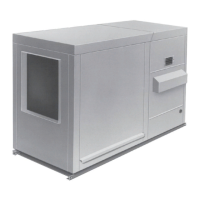43
RPB-IOM (06-22) 131782-B
Heat Exchanger Cleaning
NOTES:
• For cleaning the inner surfaces of the heat exchanger, an air hose, a long (18- to 24-inch) stiff
brush of 1/2-inch diameter or heavy wire with steel wool securely attached, a flashlight, and a
mirror are needed.
• Depending on whether or not the furnace is designed for high CFM (model prefix H), there may be
directional baffles between the heat exchanger tubes. The standard furnace has baffles between
the heat exchanger tubes. High CFM furnaces have only the top baffle support, which does not
need to be removed for cleaning.
• Furnaces designed to provide high-efficiency heating have V-shaped baffles in the top of each
heat exchanger tube. High-efficiency furnaces manufactured before MAR 1995 have a C prefix
in their model designation. All furnaces manufactured after FEB 1995 are designed for high-
efficiency and include the heat exchanger V-baffles.
1. Clean heat exchanger outer surfaces (circulating air side):
a. Gain access by removing inspection panels in ductwork or remove ductwork.
b. For standard (not high CFM) furnaces, remove baffle screws (see Figure 25) and lift each airflow baffle slightly
and slide forward. Remove all baffles from heat exchanger.
c. Remove accumulated dust and grease deposits from heat exchanger tubes and baffles using brush and/or
air hose.
d. Reinstall airflow baffles removed in step 1b and secure using baffle screws.
e. Secure ductwork as necessary.
Figure 25. Airflow Baffles
BRACKET
SCREWS
TOP BAFFLE
SUPPORT SCREWS
BAFFLE SCREWS
AIRFLOW BAFFLES
BOTTOM BAFFLE SUPPORT

